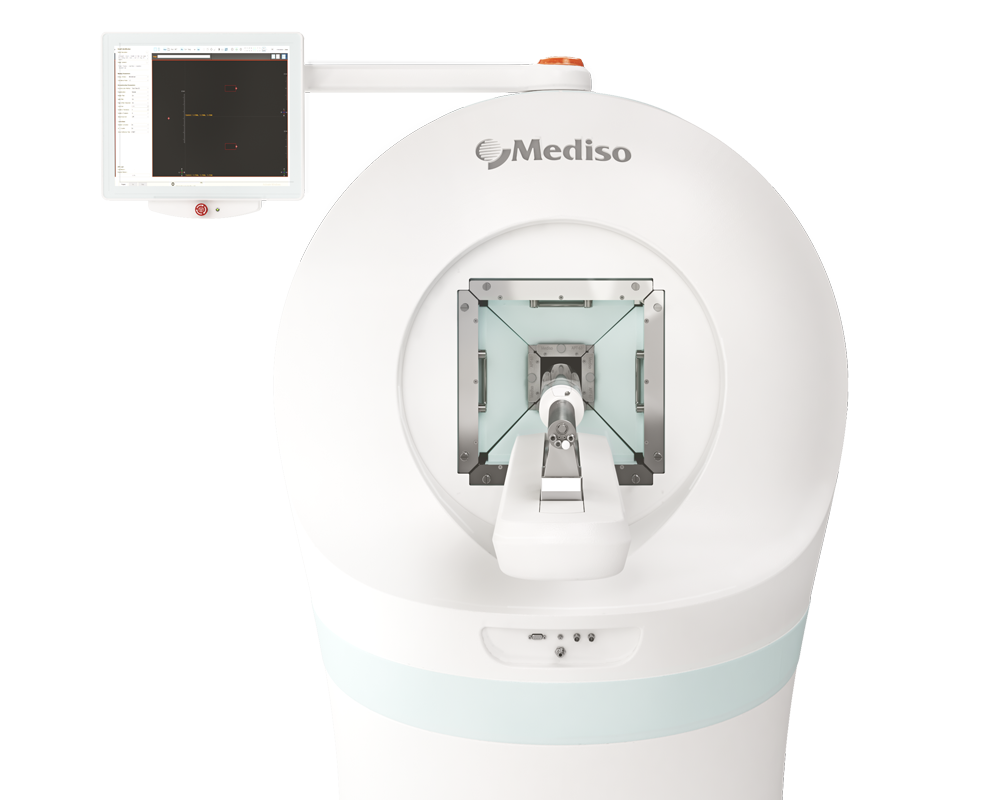Positron Emission Tomography Imaging of Acinetobacter baumannii Infection: Comparison of Gallium-68 Labeled Siderophores
2025.03.18.
Katerina Dvorakova Bendova, ACS Publications, 2025
Summary
Acinetobacter baumannii (AB) is a major hospital-acquired pathogen with rising antimicrobial resistance. Rapid detection during outbreaks is critical, but current diagnostic tools are often inadequate. This study investigates gallium-68-labeled siderophores for PET imaging of AB infections. Several siderophores were radiolabeled with high radiochemical purity (>95%), except [68Ga]Ga-FR (>91%). Two candidates, ferrioxamine E (FOX E) and ferrirubin (FR), were selected based on favorable in vitro properties. In vivo mouse and rat infection models showed fast clearance, low background uptake, and specific accumulation at infection sites. These findings suggest Ga-68-labeled siderophores as promising PET tracers for AB detection.
Results from nanoScan® PET/CT
The aim of this study was to evaluate gallium-68-labeled siderophores as potential tools for the detection of Acinetobacter baumannii (AB) infections using PET/CT imaging. Experimental animals, including Balb/c mice and rats, were anesthetized and retro-orbitally injected with either [68Ga]Ga-FOX E or [68Ga]Ga-FR at doses of 5-10 MBq. PET/CT imaging was performed 30 and 90 minutes after injection for healthy animals and 45 minutes for infected animals. A dynamic study was initiated within 5 minutes post-injection. Image reconstruction was done using Mediso Tera-Tomo 3D, and analysis was carried out using Mediso InterView FUSION. Quantitative analysis was based on standardized uptake values (SUV), comparing infected and healthy tissues across different models.
Biodistribution studies in noninfected Balb/c mice showed that both radiolabeled siderophores exhibited rapid distribution and fast blood clearance, primarily through renal excretion. [68Ga]Ga-FR showed no significant accumulation in major organs, while [68Ga]Ga-FOX E displayed some activity in the gallbladder and intestine, consistent with previously published results.

Figure 3. Maximum intensity projection (MIP) PET/CT images of in vivo biodistribution of (A) [68Ga]Ga-FOX E and (B) [68Ga]Ga-FR in healthy mice 30 and 90 min after radiolabeled siderophore administration.
In a murine model of AB-induced acute myositis, performed 5 hours before imaging, both [68Ga]Ga-siderophores showed strong signal accumulation in infected legs, with no uptake in control legs (Figure 4). Quantitative analysis confirmed significantly higher mean SUVs in infected tissue (Figure S4A). At an infectious dose of 8 × 10⁶ CFU, both tracers showed reliable uptake; [68Ga]Ga-FOX E also detected infections at 8 × 10⁵ CFU, while [68Ga]Ga-FR showed weaker signals. Minimal uptake was observed at 8 × 10⁴ CFU, suggesting a detection limit around 9 × 10² pathogens/mm³. Dynamic imaging revealed early uptake in infected tissue, increasing over time, while noninfected tissue showed declining activity (Figure S3A1, A2, S3B1, B2).
Figure 4. PET/CT in vivo imaging of (A) [68Ga]Ga-FOX E and (B) [68Ga]Ga-FR in murine model of myositis in the left hind leg induced by AB NCTC 13301 (yellow arrows) and control in the right hind leg: (1) saline (white arrows), (2) heat inactivated AB culture (green arrows) and (3) turpentine oil (blue arrows). The imaging was performed 5 h after infection and 45 min after radiolabeled siderophore administration. MIP images.
In the murine dorsal wound infection model, both [68Ga]Ga-siderophores showed clear signal accumulation at the infection site, while no uptake was observed in noninfected controls (Figure 5). Quantitative analysis confirmed a significant difference between infected and healthy animals (Figure S4B).
Figure 5. PET/CT in vivo imaging of (A) [68Ga]Ga-FOX E and (B) [68Ga]Ga-FR in normal mice (1, 4) and in murine model of wound infection induced by A. baumannii NCTC 13301 (2–3 and 5–6, yellow arrows). The imaging was performed 24 h after infection and 45 min after radiolabeled siderophore administration. MIP images.
In the rat lung infection model, both tracers showed high uptake in infected tissue, with [68Ga]Ga-FOX E demonstrating greater accumulation than [68Ga]Ga-FR, which also had higher background activity in healthy rats (Figures 6 and 7). Quantitative analysis revealed a significant difference in mean SUVs between infected and noninfected rats for [68Ga]Ga-FOX E only (Figure S4C).
Figure 6. PET/CT in vivo imaging of (A) [68Ga]Ga-FOX E and (B) [68Ga]Ga-FR biodistribution in control rat (1, 4) and in rat model of lung infection with A. baumannii NCTC 13301 (2–3 and 5–6) 48–52 h after infection and 45 min after the injection of radiolabeled siderophore. Yellow arrows indicate the site of infection. MIP images.

Figure 7. Detailed CT and PET/CT images of coronal sections of lungs of rats with AB-induced pneumonia 48 h after infection and 45 min after the injection of radiolabeled siderophores. Yellow arrows indicate the lesions in the lung tissue.
Conclusion
The study demonstrated that radiolabeled siderophores, especially [68Ga]Ga-FOX E, can effectively be imaged using the Mediso NanoScan PET/CT system, showing high accumulation in infected tissues. This supports the system’s potential for diagnosing, localizing, and monitoring AB infections.
Full article on acsinfecdis
How can we help you?
Don't hesitate to contact us for technical information or to find out more about our products and services.
Get in touch



